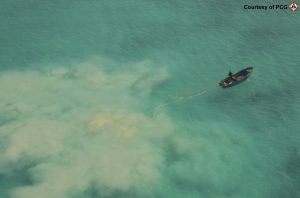The Philippines has accused Chinese fishermen of destroying the marine environment at Scarborough Shoal, a disputed feature controlled by China’s coast guard in the South China Sea, calling on Beijing to open the atoll to international scrutiny.
In a press conference yesterday, the Philippine Coast Guard (PCG) presented a series of satellite images of the coral reefs surrounding Scarborough Shoal. The reefs appeared badly scarred, which the PCG said had been caused by Chinese fishermen searching for giant clams.
“We are alarmed and worried about the situation that’s happening there,” Philippine National Security spokesman Jonathan Malaya told the press conference, calling on China to allow experts from the United Nations and environmental groups to conduct an independent inquiry into the causes of the marine destruction.
“So, that is our challenge to China,” Malaya said. “If it considers itself as protector of the environment, they should open up Bajo de Masinloc to international observers.” Bajo de Masinloc is Manila’s preferred name for the shoal.
In particular, the Philippine officials blamed Chinese fishermen for the depletion of giant clams at Scarborough Shoal. The feature lies around 198 kilometers west of Luzon, well within the Philippines internationally recognized exclusive economic zone. But the triangular atoll fell under China’s control after a 10-week stand-off with the Philippines in 2012 and the China Coast Guard (CCG) has maintained a nearly permanent presence at the shoal in the 11 years since. China’s government claims the shoal and its adjacent waters as its “inherent territory,” where Beijing “has indisputable sovereignty,” as one Foreign Ministry spokesperson put it last year.
After falling under Chinese control, Manila claims, Chinese fishing boats began mass harvesting the valuable giant clams from the shoal’s central lagoon. According to a report published in The Diplomat in early 2016, satellite images showed scarring from propellers was “visible on recent images of at least 28 reefs in the Spratly and Paracel island groups,” including Scarborough Shoal. The scarring resulted from the chopping of reefs by fishermen using propellers mounted on small boats.
Some of the photos presented at yesterday’s press conference showed Chinese fishermen harvesting large numbers of giant clams over a number of years, The Associated Press reported. But such activities seemingly stopped in March 2019, the Philippine officials claimed. “Those were the last remaining giant clams that we saw in Bajo de Masinloc,” PCG spokesperson Commodore Jay Tarriela told reporters.
He said the scarring on the reefs was “clear evidence of being careless. They don’t really care about the marine environment.”
Malaya added that consensus was building within the government about filing a legal case against China, regarding the destruction of coral reefs and features in the South China Sea. In 2013, Manila filed a wide-ranging case at an arbitral tribunal in The Hague, challenging the legality of China’s expansive “nine-dash line” maritime claim in the South China Sea. Three years, later, the tribunal ruled mostly in the Philippines’ favor. China’s government has rejected the ruling, as it will almost certainly reject Manila’s call to open Scarborough Shoal to international maritime environmental scrutiny.
Scarborough Shoal has been one of the recent flashpoints in the growing stand-off between China and the Philippines in the South China Sea, in large part due to the CCG’s efforts to prevent Filipino fisherfolk from accessing the lagoon. Last September, the CCG installed a floating barrier across the lagoon’s entrance, which the PCG later removed. Since then, there have been a number of skirmishes with Philippine patrol ships and fishing boats. Most recently, on April 30, CCG vessels fired water cannons at a PCG patrol ship and fisheries patrol boat, causing significant damage to both.

































